Papers by Frances Westley
Social innovations must take into account the complexity of social problems and foster solutions ... more Social innovations must take into account the complexity of social problems and foster solutions resilient enough to adapt and survive.
The Evolution of Social Innovation
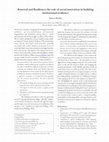
African health sciences, 2008
Society faces a number of ongoing and seemingly intractable problems – poverty, homelessness, env... more Society faces a number of ongoing and seemingly intractable problems – poverty, homelessness, environmental degradation, and disabilities among others – which governments and NGOs struggle to address. When efforts fail, it could be said that the system is caught in a trap, unable to respond to “chronic disasters” (Erikson, 1994) or immediate crises. On the other hand, social innovation, generally associated with creative initiatives on the part on one or many individuals, can at times transform such trapped systems. How and why does this happen? This abstract draws on a framework developed by a group of interdisciplinary scholars known as the Resilience Alliance (www.resalliance.org). This group, initially led and created by C.S Holling focuses on linked social and ecological resilience, defined as follows: Ecosystem resilience is the capacity of an ecosystem to tolerate disturbance without collapsing into a qualitatively different state that is controlled by a different set of proc...
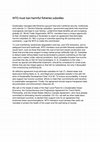
Science, 2021
Sustainably managed wild fisheries support food and nutritional security, livelihoods, and cultur... more Sustainably managed wild fisheries support food and nutritional security, livelihoods, and cultures (1). Harmful fisheries subsidies-government payments that incentivize overcapacity and lead to over-fishing-undermine these benefits yet are increasing globally (2). World Trade Organization (WTO) members have a unique opportunity at their ministerial meeting in November to reach an agreement that eliminates harmful subsidies (3). We-a group of scientists spanning 46 countries and 6 continents-urge the WTO to make this commitment. To curb overfishing, biodiversity degradation and loss, and CO2 emissions, and to safeguard food and livelihoods, WTO members must prohibit fisheries subsidies that cause harm, such as those that lower the cost of fuel and vessel construction and those that provide price support to keep market prices artificially high (2). Subsidies to distant-water fishing fleets must be eliminated to prevent overfishing on the high seas and in waters under national jurisdiction. Such subsidies threaten low-income countries that rely on fish for food sovereignty (4, 5). Exceptions to the rulesknown as special and differential treatment-should be considered for small-scale fishers that use low-impact gears or that fish for subsistence, but only if decoupled from incentivizing overfishing (6). An effective agreement must eliminate subsidies for fuel (7), distant-water and destructive fishing fleets (4, 5), and illegal and unregulated vessels in line with the aims of Sustainable Development Goal 14.6 (8). To ensure accountability, it should also support low-income countries' efforts to meet their commitments and transition to sustainable management. Finally, the agreement should require transparent data documentation and enforcement measures (9). We call on the heads of state of the High Level Panel for a Sustainable Ocean Economy, the Comprehensive and Progressive Agreement for Trans-Pacific Partnership, and the United States-Mexico-Canada Agreement-who have already committed to eliminating harmful subsidies (10-12)-as well as other trade blocs and individual countries, to declare their support now for an agreement that enshrines these recommendations. WTO members must harness their political mandate to protect the health of the ocean and the well-being of society.
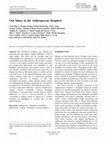
Ambio, 2021
The COVID-19 pandemic has exposed an interconnected and tightly coupled globalized world in rapid... more The COVID-19 pandemic has exposed an interconnected and tightly coupled globalized world in rapid change. This article sets the scientific stage for understanding and responding to such change for global sustainability and resilient societies. We provide a systemic overview of the current situation where people and nature are dynamically intertwined and embedded in the biosphere, placing shocks and extreme events as part of this dynamic; humanity has become the major force in shaping the future of the Earth system as a whole; and the scale and pace of the human dimension have caused climate change, rapid loss of biodiversity, growing inequalities, and loss of resilience to deal with uncertainty and surprise. Taken together, human actions are challenging the biosphere foundation for a prosperous development of civilizations. The Anthropocene reality—of rising system-wide turbulence—calls for transformative change towards sustainable futures. Emerging technologies, social innovations,...
SSRN Electronic Journal, 2020

Ecology and Society, 2020
The trajectory the world is on is unsustainable; climate change, diseases/epidemics, mass migrati... more The trajectory the world is on is unsustainable; climate change, diseases/epidemics, mass migrations, socialeconomic collapse, unrelenting loss of biodiversity being some of the symptoms. Transformational changes are needed in the drivers of the current trends, and a tentative list of such drivers includes: (i) the economic system, (ii) homogenization, (iii) human population growth, size, and densities, (iv) consumption patterns, human ethics, and behavior, and (v) governance. Where and how to intervene? The adaptive cycle is suggested as an appropriate framework. A critical phase in the cycle is the brief period after crisis when novelty and innovation can change the future trajectory. Without being prepared for this window of opportunity, deep, systemic change may be unachievable. If response to the present COVID crisis merely reinforces the existing system, its incompatibility with the natural world and its propensity to increase inequity and conflict will likely increase fragility and lead to another version of the present calamity.

The Evolution of Social Innovation, 2017
This chapter walks the reader through a broadly systemic analysis of three historic cases of soci... more This chapter walks the reader through a broadly systemic analysis of three historic cases of social innovation (Dutch East India Company, Derivatives Trading and the Internet) to distil key insights or patterns of systemic change for scholars and practitioners of social innovation. These patterns can be interpreted using conceptual tools, metaphors or heuristics from complexity theories so as to both help explain the phenomena and enable social innovators to recognize, and even replicate, patterns of systems behaviour in the complex, evolving systems they are seeking to transform. While this chapter is not the first attempt to apply insights from complexity and chaos theories to understanding social systems, social change or innovation, it combines insights from pre-existing theories of social innovation, concepts like the “Adjacent Possible†, with ideas from chaos theory and complexity theory.  The resulting complexity-based interpretation highlights both the hope and the potential unintended consequences of any innovation.
Ecology and Society, 2018
The relationship between art and science is one of contrasts and commonalities. We look at one co... more The relationship between art and science is one of contrasts and commonalities. We look at one commonality between art and science: the central role of iconic images. We argue that iconic images are the touchstone symbols in both art and science and provide similar functions for both. We propose that these iconic images provoke an openness and a receptivity to our deepest emotional capacities and a connection between those and the dynamics of the broader social-ecological systems in which we operate. Such iconic images may also act as attractors that provoke the emergence of increasing levels of intellectual and aesthetic self-organization, not only at an individual level, but also in terms of larger social, scientific, or artistic fields. Finally, through a combination of this attraction and this connection, iconic images may play a role in transformation.
Canadian journal of nonprofit and social economy research, 2011
Revue canadienne de recherche sur les OBSL et l'économie sociale Book Review by Raymond Dart Voic... more Revue canadienne de recherche sur les OBSL et l'économie sociale Book Review by Raymond Dart Voices from the Voluntary Sector: Perspectives on leadership challenges. Edited by Frederick Bird and Frances Westley. Toronto: University of Toronto Press, 2011. 459 pp. ISBN 9780802096616 (pkb).
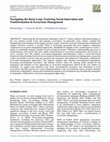
Ecology and Society, 2010
Addressing the environmental challenges of the 21 st century requires substantial changes to the ... more Addressing the environmental challenges of the 21 st century requires substantial changes to the way modern society views and manages ecosystems. In particular, many authors contend that fundamental transformation of the largely sectoral, expert-centered ecosystem-management institutions of modern, Western societies is needed. There is increasing agreement that more adaptive, integrated, collaborative ecosystem-management approaches, interlinked at multiple scales, would improve society's ability to sustainably manage complex social-ecological systems. Therefore, understanding processes of transformation, and factors that may enable transformation in ecosystem management, has become an active research area. We explore ecosystem-management transformations using a social-innovation framework. Based on three local-level case studies of transformation in freshwater management, we provide a pilot assessment of factors that may promote the emergence and adoption of integrated, collaborative ecosystem-management approaches. Our analysis suggests that ongoing environmental degradation, increasing environmental awareness, and shifting societal values are creating fertile ground for the emergence and adoption of new approaches to ecosystem management. Based on the case studies we examined, we suggest that initiatives that foster environmental awareness and attachment to local ecosystems, develop capacity for social entrepreneurship in the environmental arena, promote dialogue between key stakeholders, and provide institutional support to new institutions may facilitate the emergence of integrated, collaborative ecosystem-management approaches.

Ecology and Society, 2014
A recent focusing event involving the death of a moose in the Dome open-pit mine in the community... more A recent focusing event involving the death of a moose in the Dome open-pit mine in the community of Timmins, in northern Ontario, Canada has triggered the opening of a policy window related to the governance of resource extraction by indigenous peoples. This event, combined with several other factors, including: (1) the high price of gold; (2) a mining company seeking to demonstrate corporate social responsibility to repair its international reputation with indigenous peoples by supporting an innovative, local Indigenous-led initiative; and (3) a new policy context, including Supreme Court of Canada decisions and provisions in the updated Ontario Mining Act, that require meaningful consultation with indigenous peoples has led to the emergence of a indigenous peoples-led collaborative, social innovation. This policy window allowed for the formation of an unprecedented council of indigenous knowledge holders (elders) and traditional practitioners to help inform mine restoration and practice as well as to foster the resurgence of traditional language and culture in local indigenous communities. Here, we document this unprecedented social change opportunity.
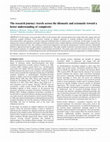
Ecology and Society, 2014
In this paper, seven researchers reflect on the journeys their research projects have taken when ... more In this paper, seven researchers reflect on the journeys their research projects have taken when they engage with and synthesize complex problems. These journeys embody an adaptive approach to tackling problems characterized by their interconnectedness and emergence, and that transcend traditional units of analysis such as ecosystems. In this paper we argue that making such a process deliberate and explicit will help researchers better combine different research paradigms such as expert-driven and participant-directed work, thus resulting in both broad explanations and specific phenomenon; research tensions traditionally defined as oppositional must be approached as complimentary. This paper includes researchers' personal journeys as they dealt with the emergent properties of complex problems and participant involvement. This paper argues that that research journey should be more than accidental but is a methodological necessity and should guide the theoretical and practical approaches to complex problems.

The Journal of Applied Behavioral Science, 2014
Why do so many social innovations fail to have a broad impact? Successful social entrepreneurs an... more Why do so many social innovations fail to have a broad impact? Successful social entrepreneurs and nonprofit organizations often “scale out” innovative solutions to local problems in order to affect more communities or numbers of individuals. When faced with institutional barriers, they are motivated to “scale up” their efforts to challenge the broader institutional rules that created the problem. In doing so, they must reorient their own and their organizations’ strategies, becoming institutional entrepreneurs in the process. This article proposes a contextual model of pathways for system change consisting of five different configurations of key variables and informed by qualitative interview data from selected nonprofit organizations. The authors argue that the journey from social to institutional entrepreneurship takes different configurations depending on the initial conditions of the innovative initiatives. Despite an expressed desire to engage in system change, efforts are oft...

Society & Natural Resources, 2002
Biologists have made considerable progress in developing realistic simulation models to predict e... more Biologists have made considerable progress in developing realistic simulation models to predict extinction risks for threatened species. Social scientists have to date had a more limited role in these efforts. This limited involvement comes despite the growing acknowledgment by population biologists and simulation modelers that this additional input is necessary for these models to accurately re¯ect the impact of humans and human-dominated landscapes on wildlife populations. We argue that collaborations among social and biological scientists can provide unparalleled opportunities to develop new conceptual and simulation tools for biodiversity risk assessment. One challenge is that while the value of interdisciplinary research is widely recognized, interdisciplinary teamwork is dif®cult to achieve. We suggest strategies to strengthen such cross-disciplinary collaboration, including efforts to link diverse models and to

Journal of Social Entrepreneurship, 2012
A key challenge for governments faced with increasingly limited financial resources lies in findi... more A key challenge for governments faced with increasingly limited financial resources lies in finding new ways of partnering with the not-for-profit sector to deliver innovative solutions to intractable social problems. This allows government to tap into previously inaccessible resources contained in local communities, and to harness them to produce social goods. However, it also requires that government take on a new role as a facilitator of social innovation rather than a direct actor, which poses a challenge for both theorists and practitioners. This paper is based on a qualitative investigation of the Big Green Challenge, a competition designed to stimulate community groups to generate programs to tackle climate change in their localities. It examines the role that similar challenge grants and competitions might play in stimulating social innovation and asks questions about how government can help innovations to scale up and out.

Journal of Social Entrepreneurship, 2012
This paper explores social finance as a strategy for generating social innovations and, at the sa... more This paper explores social finance as a strategy for generating social innovations and, at the same time, financial returns. It explores why risk assessment for social finance is so challenging and suggests three sources of difficulty: setting boundaries, integrating heterogeneous values, and responding with sufficient speed and flexibility to support innovation. It suggests links between the seemingly distinct challenges of social finance being able to maximize its impact at different stages of the innovation process in a complex socio-ecological system, whilst also acting as a reframing agent in terms of the understanding of the system itself at other stages. Finally, this paper develops a new concept 'developmental impact investing' as a modified version of a portfolio strategy that uses a range of projects both to manage risk and to generate new knowledge about the complex systems in which the social finance attempts to create impact and innovation.






Uploads
Papers by Frances Westley